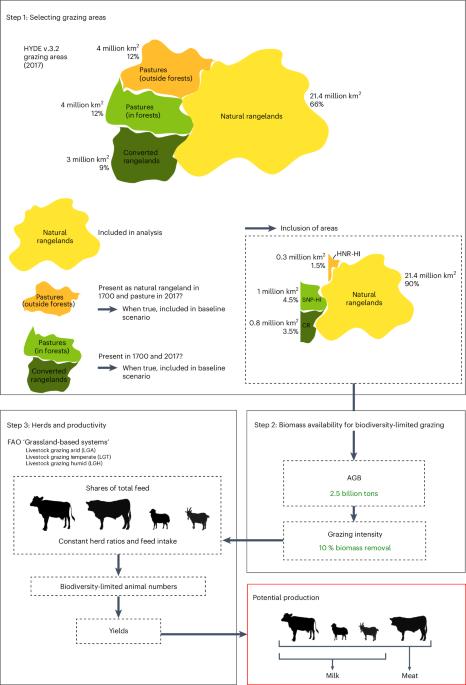An exploration of biodiversity limits to grazing ruminant milk and meat production
IF 25.7
1区 环境科学与生态学
Q1 ENVIRONMENTAL SCIENCES
引用次数: 0
Abstract
The production and consumption of animal-source foods must be transformed to mitigate negative environmental outcomes, including greenhouse gas emissions and land-use change. However, livestock are also key for food production and for livelihoods in some settings, and they can help preserve biodiversity and certain ecosystems. Previous studies have not yet fully explored sustainability limits to the use of grazing lands for food production in the context of biodiversity. Here we explore ‘biodiversity limits’ to grassland ruminant production by estimating the meat and milk production from domestic ruminants limited to grazing areas and stocking densities where livestock can contribute to the preservation or restoration of biodiversity. With biodiversity-friendly grazing intensities at 0–20% biomass removal depending on aridity, this take on biodiversity limits corresponds to 9–13% and 26–40% of the current grassland-based milk and meat production, respectively. This equals only 2.2 kg of milk and 0.8 kg of meat per capita per year, globally, but altered management and moving from meat-specialized to meat-and-dairy systems could increase the potential production while still remaining within this approach to biodiversity limits. Grazing lands make important contributions to society, including meat and milk, but there are sustainability limits to their use for production. This study explores milk and meat production from grazing ruminants within biodiversity limits.

探索生物多样性对放牧反刍动物奶和肉生产的限制
必须改变动物源食品的生产和消费,以减轻对环境造成的负面影响,包括温室气体排放和土地使用的变化。然而,在某些情况下,牲畜也是粮食生产和生计的关键,而且它们有助于保护生物多样性和某些生态系统。以往的研究尚未充分探讨在生物多样性背景下利用牧场进行粮食生产的可持续性限制。在这里,我们通过估算家养反刍动物在放牧区和放牧密度下的肉类和奶类产量,来探索草原反刍动物生产的 "生物多样性极限"。根据干旱程度,生物多样性友好型放牧密度的生物量去除率为 0-20%,生物多样性限度分别相当于目前草原奶类和肉类产量的 9-13% 和 26-40%。这相当于全球每年人均牛奶产量仅为 2.2 千克,人均肉类产量仅为 0.8 千克,但改变管理方式,从肉类专用系统转向肉奶兼用系统,可以提高潜在产量,同时仍能保持在生物多样性极限范围内。放牧地为社会做出了重要贡献,包括肉类和奶类,但其生产使用存在可持续性限制。本研究探讨了在生物多样性限制范围内利用放牧反刍动物生产牛奶和肉类的问题。
本文章由计算机程序翻译,如有差异,请以英文原文为准。
求助全文
约1分钟内获得全文
求助全文
来源期刊

Nature Sustainability
Energy-Renewable Energy, Sustainability and the Environment
CiteScore
41.90
自引率
1.10%
发文量
159
期刊介绍:
Nature Sustainability aims to facilitate cross-disciplinary dialogues and bring together research fields that contribute to understanding how we organize our lives in a finite world and the impacts of our actions.
Nature Sustainability will not only publish fundamental research but also significant investigations into policies and solutions for ensuring human well-being now and in the future.Its ultimate goal is to address the greatest challenges of our time.
 求助内容:
求助内容: 应助结果提醒方式:
应助结果提醒方式:


